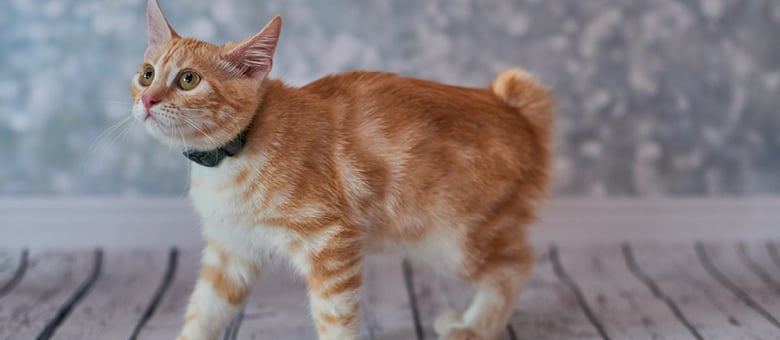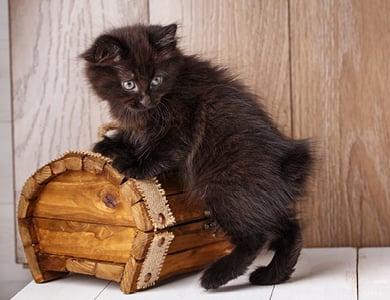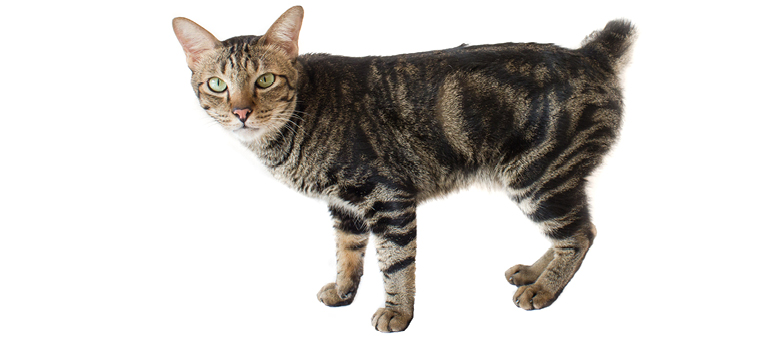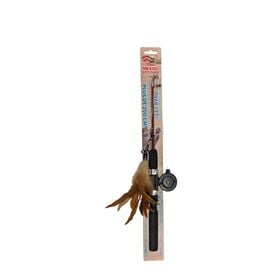The American bobtail got its name from its shortened or “bobbed” tail. This trait appears naturally in the animal world when one or more genes related to the tail mutate. This spontaneous mutation can occur only in the individual, but it can also be passed on to its descendants, which is what happened in the case of the American bobtail. The breed is therefore the result of a spontaneous mutation in the genome of the American domestic cat. The American bobtail has no relation to the bobcat, or any other short-tail breeds that already existed at the time (such as the Manx and the Japanese bobtail).
Morphology and appearance
The American bobtail is a medium- to large-size semi-cobby cat with a sturdy bone structure and well-developed muscle tone. It has a rectangular shaped body, broad chest and slightly arched back. Its hind legs are somewhat longer than its front legs. The head is broad, with a strong chin and a rounded triangular-shaped muzzle that is a little wider than it is long. The ears, of average size, sit quite low on the skull, and each has a tuft of fur at the end known as “lynx tips.” The eyes, which are big and slightly almond shaped, come in all colours.
The American bobtail comes in all colours and coat patterns. Its short- or medium-length coat is rather shaggy, with a dense undercoat. The medium-length variety has tufts of fur between the toes.
The main feature of the American bobtail is of course the tail! It’s never absent, but always short, with a maximum length generally towards the tarsus (the hock). It can be straight, curved, kinked or bent inward. The hair on the tail is bushy and quite long. Although smaller than normal, the tail is perfectly functional and can convey the cat’s emotions exactly like a normal tail.
Level of maintenance (grooming)
The American bobtail’s coat is low maintenance. This cat breed—even the variety with a medium-length coat—loses very little hair, except maybe during shedding seasons. Brushing is therefore recommended a little more often during these periods, and approximately once a week in between.
Behaviour
Affectionate, playful, calm, curious and sociable, the American bobtail is generally a well-balanced cat that adapts easily to different situations. It can be walked on a leash through the woods or it can surprise you by learning how to open doors and drawers. This tiny lynx might also prefer to curl up on someone’s lap and enjoy the warmth of the fireplace.
Origins
The American bobtail is a very recent breed whose history begins in the U.S. around the late 1960s. At the time, a young couple from Iowa came across a kitten like no other while vacationing around a reserve in Arizona. The kitten in question had a tiny tail. The couple fell under the kitten’s spell, named it Yodi and brought it home with them. Yodi wooed the family’s colour-pointed cat, which gave birth to a litter of short-tailed kittens. The gene seemed to be easy to pass on. Breeder friends Mindy Shultz and Charlotte Bentley were intrigued by these kittens and decided to turn them into an official breed. Yodi’s descendants served as the basis for the creation of the American bobtail. Domestic cats with the characteristic short tail were found throughout the U.S. and Canada, helping create the breed’s genetic diversity. Today, the use of cats without a pedigree is no longer needed to keep the breed healthy.
Unusual facts
The gene responsible for the American bobtail’s unusual tail is probably a variant of the Manx gene, since the American bobtail still has a tail, no matter how short. Since it is still not well understood, the mutation is impossible to control, resulting in a wide range of lengths and shapes of tails.
There is some concern that the American bobtail’s short-tail gene leads to other spinal deformities. However, there are very few reported cases, and none are as serious as those of the Manx.









